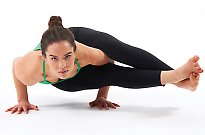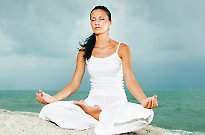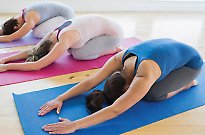
The physiological benefits of yoga

Getting in touch with your inner yogi.
Yoga teacher Emma Palmer shares the physical benefits of yoga.
The concept that hinges on an active door never rust can also be said for ourselves. Why is that? This is because we function at our best and feel most fulfilled and alive when some level of movement is applied, whether that is to our minds, bodies, spirit or emotions. Without movement, we stagnate at every level of our being and the practice of yoga and its holistic approach is key to maintaining wellness.
The movement that occurs within the practice of yoga is like no other. The intelligence of a well-sequenced yoga practice means that we can create a balanced flow of postures that are stimulating, heating and energising as well as postures that have a calming, restorative and nourishing effect. However, something much deeper is taking place to those courageous enough to roll out their mats and commit to a path that has the capacity to take the sadhaka (student of yoga) through a journey of healing and wholeness. It doesn’t take too long before the realisation occurs that movement may begin with the physical but it is the movement within, on a subtle level, that ignites the inner fire of transformation.
Motion is lotion
If we begin at the physical level, vinyasa krama (step-by-step progression) develops strength within the large muscle groups as well as the smaller accessory muscles while increasing flexibility, all without compromising or placing undue pressure on the integrity of the joints. Chronically tense muscles contribute to decreased blood circulation, which in turn can affect spinal alignment and vice versa. This impacts the function of our internal organs and systems, as well as our overall mobility. Yogasana (yoga asanas) increases blood flow to the entire musculoskeletal system, thereby increasing nourishment and reducing waste by-products within the muscle tissues.
A vinyasa practice also supports the body’s natural anti-inflammatory processes. It increases prostaglandin synthesis in the walls of blood vessels by regulating the contraction and subsequent relaxation of smooth muscle tissue throughout the body.
In the past, some have perceived yoga to be a more gentle practice with little or no cardiovascular component. This, of course, to a certain extent is true and depends on the style and pace of practice chosen; however, the cardiorespiratory output during a vinyasa power flow can be immense. This is evident when observing students at the end of the limbering and standing series and seeing their sweat drip poetically onto their mats below.
This is supported by research highlighting the significant aerobic activity created by the practice of asana. A research study compared the effects of 32 minutes of standing asana versus 32 minutes of walking on a treadmill at seven kilometers per hour. The study concluded that participants practising the standing postures had a greater increased heart rate and increased systolic and diastolic blood pressure, all of which was achieved with a lower metabolic demand.
Ageing gracefully
There is a part of the brain called the globus pallidus, which contributes to the regulation of voluntary movement. It has the ability to sustain static yoga postures for an extended period of time, as well as contributing to the bracing effort that is needed for each posture. This is often why we favour some postures over others, particularly postures we love the most and find less challenging to practise. Through the practice of asana, the globus pallidus has the capacity to constantly learn new ways of moving. If the body only moves in familiar patterns, it impedes the growth of this part of the brain. This means that as we age, this function begins to decrease, so the neural pathways to this part of the brain start to stiffen and, as a result, so do our muscles.
The movement of yoga also supports the actions of proprioception and interoception – key components of the central nervous system that support us to sense spacial orientation of the body while in motion, particularly when yoga postures are held for a longer period of time (such as standing and balancing postures). Interoception, on the other hand, is related to the sensitivity of the internal physiological reactions to each posture. When these internal mechanisms are switched on and refined, we create a body that supports us in the latter stages of life and during the natural ageing process. Furthermore, this aids in the prevention of age-related falls and their associated complications.
The rhythm of the breath is the key
It is Sri K. Pattabhi Jois who said: “Incorrect breathing equals pain coming.” This is primarily because muscles have the best opportunity to relax into an asana when the breath is even and rhythmical. Muscles stretch and relax on an exhale, which in turn guides you deeper into the asana over time. Every asana is strategically preceded with an inhale and followed by an exhale and the rhythm of this breathing pattern is established throughout the practice using ujjayi pranayama (yoga breathing).
This not only increases flexibility but also reduces the presence of any muscular tension or tightness, decreasing the risk of injury, which in turn keeps the mind and body relaxed even when practising the most challenging postures. Furthermore, during a yoga practice, bandhas – subtle internal locks – are applied in conjunction with the breath as a means to apply subtle muscular contraction to protect and support the major joints, preventing the risk of injury during static and moving postures without exacerbating existing injuries.
Emotions = energy in motion
Asana is primarily designed to move energy and it is not uncommon for a yoga teacher to share the wisdom of how, why and where energy is moving in particular asana and pranayama practices. The movement of energy specifically refers to energy known in yoga as prana versus the energy of glucose and glycogen used as fuel. Yoga practices not only rebalance the energy in the physical body, prana also removes stagnation from the energy channels, referred to as nadis. This can be experienced when we find that one side of the body is more fluid and effortless yet the opposite side feels tight and restricted, which can also be influenced by the time of day you practise.
Moving the life force
The prana vayus (literally translated as winds) are vital principles of subtle energy that sustain physiology and subsequently maintain health. There are five major prana vayus; prana, apana, samana, udana and vyana. Vyana vayu is responsible for the movement of energy for the musculoskeletal system, increasing blood circulation, coordinating balance and proprioception and executing movement. When this energy is out of balance, the mind becomes fractious, irritable and anxious. Yoga practices support the body to rebalance systemic physiology responsible for boosting energy, vitality and transporting nutrition needed throughout the body.
Moving keeps you happy
Furthermore, our brain biochemistry responds positively to the movement of asana by increasing hormones and neurotransmitters that keep our emotions balanced and positive, allowing our cognitive ability to perceive our experiences of life as teachings and an opportunity for growth rather than overwhelming challenges. Research is consistently confirming the positive influence of yoga practices on lowering the stress hormone cortisol and contributing to the feeling of that yoga high you experience in savasana (corpse pose) at the end of a yoga practice. Endorphin release is stimulated in the practice of yogasana and assists in pain relief, boosting immunity, reducing stress and delaying the ageing process. The endorphin release varies from person to person and some may feel the effects after just five rounds of surya namaskar (sun salutations). Others, however, may experience this release in stillness of savasana.
Looking to update your yoga gear? Check out Anaconda's range of yoga mats and accessories and be on your way to a refreshing yoga experience.
Read more about the added benefits of yoga.


